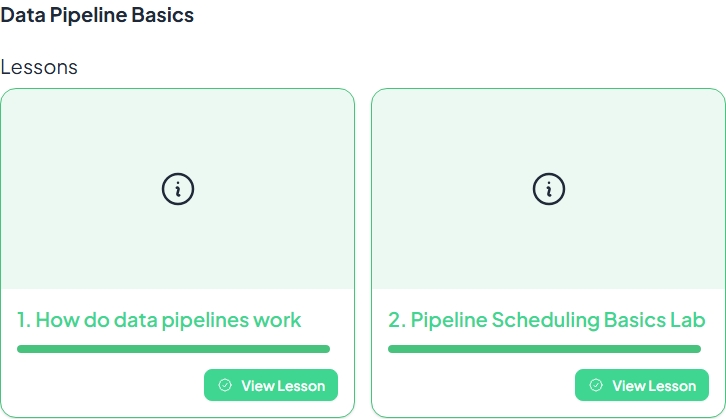Beginner DE Bootcamp: Data Pipeline Basics
As part of Zac Wilson’s Beginner Data Engineering Bootcamp on DataExpert.io, I just finished the Data Pipeline Basics module. This lesson introduced me to the fundamentals of pipelines, why they matter, and how scheduling plays a role in automating data workflows.
What is a Data Pipeline?
A data pipeline is a system that allows data to move from one place to another, often transforming it along the way. The end goal is to turn raw data into insight or knowledge that supports better business decisions.
Pipelines are not only critical for analytics — they are also important in AI systems, where this concept is often referred to as context engineering: getting all the right data into one place so that models can use it effectively.
Types of Data Pipelines
I learned that pipelines can be classified into three main types:
- Scheduled Pipelines
- Run at fixed intervals (e.g., hourly, daily).
- Example: generating a daily sales report.
- Real-time Pipelines
- Process events as soon as they happen.
- Example: fraud detection systems, which must react instantly to new transactions.
- On-demand Pipelines
- Triggered only when needed.
- Example: processing a dataset uploaded by a user.
Scheduling with Cron and Other Tools
Scheduling is a fundamental part of pipelines. One of the most common tools is Cron, which allows you to schedule tasks to run automatically at specific times or intervals. For example, you can run a job every 5 minutes or once a day at midnight.
Beyond Cron, there are full-featured orchestration frameworks that help manage pipelines:
- Apache Airflow
- Dagster
- Prefect
- Mage
These tools provide features like retries, monitoring, and dependency management, making it easier to keep pipelines reliable at scale.
My Hands-On Project: Adding Scheduling to My Extractor
In the previous module, I built a Python script (script.py) that connects to the Polygon.io API, fetches stock tickers, and saves them into a CSV file.
In this module, I took the project a step further by introducing scheduling. I created a new script, scheduler.py, which imports and runs the run_stock_job function from script.py at regular intervals.
Here’s what scheduler.py does:
- Defines a simple job that prints the time when it runs.
- Uses the
schedulePython library to run tasks every minute. - Calls the
run_stock_jobfunction (fromscript.py) on a schedule, so the CSV file gets updated automatically.
Code snippet from scheduler.py:
1
2
3
4
5
6
7
8
9
10
11
12
13
14
15
import schedule
import time
from script import run_stock_job
from datetime import datetime
def basic_job():
print("Job started at", datetime.now())
# Run every minute
schedule.every().minute.do(basic_job)
schedule.every().minute.do(run_stock_job)
while True:
schedule.run_pending()
time.sleep(1)
I also experimented with Windows Task Scheduler to run scheduler.py automatically. This way, even if I forget to run the script manually, the operating system takes care of it for me.
Takeaways
This module helped me understand that pipelines are about much more than moving data. They are about automation, reliability, and timing.
By connecting my extractor script to a scheduler, I experienced first-hand how a simple pipeline can evolve from a one-off script into a repeatable process. This is the foundation of real-world data engineering.
Thanks again to Zac Wilson. The Data Pipeline Basics module made the concepts much more tangible, and I’m excited to keep building on this.
